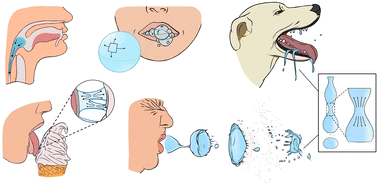Pinching dynamics, extensional rheology, and stringiness of saliva substitutes†
Abstract
Saliva substitutes are human-made formulations extensively used in medicine, food, and pharmaceutical research to emulate human saliva's biochemical, tribological, and rheological properties. Even though extensional flows involving saliva are commonly encountered in situations such as swallowing, coughing, sneezing, licking, drooling, gleeking, and blowing spit bubbles, rheological evaluations of saliva and its substitutes in most studies rely on measured values of shear viscosity. Natural saliva possesses stringiness or spinnbarkeit, governed by extensional rheology response, which cannot be evaluated or anticipated from the knowledge of shear rheology response. In this contribution, we comprehensively examine the rheology of twelve commercially available saliva substitutes using torsional rheometry for rate-dependent shear viscosity and dripping-onto-substrate (DoS) protocols for extensional rheology characterization. Even though most formulations are marketed as having suitable rheology, only three displayed measurable viscoelasticity and strain-hardening. Still, these too, failed to emulate the viscosity reduction with the shear rate observed for saliva or match perceived stringiness. Finally, we explore the challenges in creating saliva-like formulations for dysphagia patients and opportunities for using DoS rheometry for diagnostics and designing biomimetic fluids.

- This article is part of the themed collection: Food as Soft Matter


 Please wait while we load your content...
Please wait while we load your content...